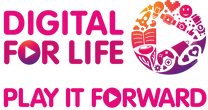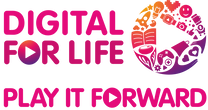In today’s digital age, we use various apps for communication, including social media platforms like Facebook, Tik Tok, Instagram and YouTube, as well as instant messaging apps like WhatsApp and Telegram. These tools allow us to connect with friends, family, and colleagues instantly through text, voice, video calls, and media sharing.
While social media and instant messaging apps offers many benefits, they also come with risks that users should be mindful of:
- Privacy concerns from data collection and sharing of personal information.
- Excessive screen use and addiction, affecting your well-being and daily life.
- Exposure to inappropriate content.
- Risky trends and challenges that may encourage unsafe behaviour.
- Misinformation and fake news, which can influence your perceptions and decisions.
- Scams and phishing attempts that threaten your money and identity.
- Cyberbullying and online harassment, affecting mental health and safety.
- Potential encounters with online predators.
Learn more about their features, how they are used and tips for staying safe while using them.
The information provided is for reference only and does not constitute reviews or endorsements by IMDA.

What is Facebook?
Facebook, owned by Meta, is a social networking platform launched in 2004. Facebook helps you connect with friends, family and communities of people who share your interests. Connecting with your friends and family as well as discovering new ones is easy with features like Groups, Watch and Marketplace.
With over 3 billion active users worldwide, it is one of the most popular platforms for communication and entertainment.
Age rating: 13+
How do people use Facebook?
People use Facebook to:
- Stay connected with loved ones.
- Share updates, photos, and videos.
- Join groups or events based on interests.
- Follow pages for news, entertainment, or businesses.
How can you use Facebook safely?
When you share content on Facebook technologies, you control what information is visible to your friends and to the public. It’s up to you to decide who can see your content.
- Start with a Facebook Privacy Checkup, which guides you through some of your privacy and security settings to make sure that you’re sharing with the people you want to see your content.
- Adjust Settings to control who sees your posts and profile details, how people can interact with you. Control who can comment on your posts and send you direct messages.
- Enable Two-Factor Authentication to add an extra layer of security to your account.
- Be cautious online and avoid sharing sensitive information like your location or contact details. Only accept friend requests from people you know.
- Think before you click and always verify links and messages to avoid phishing scams.
Learn more about how to stay safe at the Meta Safety Centre.
How can you report a problem or block someone?
As with any social media platform, you may come across issues like inappropriate content, harassment, or scams that require reporting content or blocking a user. Here’s how you can take action:
- Report abuse
You can report inappropriate and abusive content for review. Content that violates Meta’s policies will be removed. . - Blocking someone
You can also block someone to unfriend them. This will prevent them from starting conversations with you on Messenger or Facebook chat or seeing things you post on your profile. In addition, people you block can no longer tag you or invite you to events or groups. - Restricting someone
Your Restricted list is for people you’ve added as a friend but may not want to share with. When you add someone to your Restricted list, you’ll still be friends with them on Facebook, but they'll only be able to see your public profile information, public posts and posts you tag them in.
Advice for Parents and Caregivers
As a parent, you may be concerned about how your teens are engaging on Facebook. Here are some resources that you can refer to, to keep your children safe on Facebook: Refer to the Meta Family Center here.
If you would like to learn how you can set parental controls on your child’s devices, visit our page on Understanding Parental Controls.
Other Key Safety Links
- Help centre
Offers a range of general help, safety and security information and popular topics. - Privacy policy
Outlines Facebook’s policy on the type of information they collect and how they use it. - Community Standards
Learn what is and isn't allowed on Meta platforms.
What is Instagram?
Instagram, owned by Meta, is a widely used social media platform for visual storytelling. Users can choose to share their content with the public, followers, or close friends. Key features include ‘Stories’ (24-hour disappearing content), ‘Reels’ (short, music-backed videos), ‘DMs’ (private messages), ‘Discover’ (discover content and creators based on your interests) and ‘Shopping’ (browse latest trends from brands and creators).
Age rating: 13+
How do people use Instagram?
People use Instagram to:
- Share moments from their daily lives
- Follow friends, celebrities, and brands
- Discover new content through hashtags and explore pages
- Connect with others through direct messages and comments
- Promote businesses and personal brands
How can you use Instagram safely?
To protect yourself, you can
- Set your account to private so that only approved followers can see your posts.
- Enable two-factor authentication to add an extra layer of security to your account.
- Set login alerts so you know when someone tries logging in to your account from a device we don’t recognise.
- Manage your privacy settings to control who can message you and tag you in posts.
- Be cautious about sharing personal information: Avoid posting sensitive details like your location or contact information.
- Use the "Close Friends" feature to share certain content with a select group of people.
Learn more about how to stay safe at the Meta Safety Centre.
How can you report a problem or block someone?
As with any social media platform, you may come across issues like inappropriate content, harassment, or scams that require reporting or blocking a user. Here’s how you can take action:
- Report abuse
You can report inappropriate and abusive content for review. Content that violates Meta’s policies will be removed. - Blocking someone
You can block a user to stop them from viewing your posts or engaging with you.
Advice for Parents and Caregivers
If your child is over 13 and under 18 years old, they will be assigned Teen Accounts automatically. Teen Accounts keep your child safe by limiting unwanted contact, showing them age-appropriate content and help them manage their time on Instagram.
You can also set up supervision in Family Center on Instagram to support your child. With supervision set up, you can
- Set time limits and schedule breaks using parental controls.
- Monitor who your child follows and who follows them.
- Adjust privacy and sensitive content settings.
If you would like to learn how you can set parental controls on your child’s devices, visit our page on Understanding Parental Controls.
Advice for Youth
To enhance your safety, certain privacy settings are automatically applied based on your age. If you are under 16, you’ll need to add a parent or guardian to supervise your account before you can change your teen safety settings to be less protective. Learn how to set up supervision on Instagram.
Visit this page to understand more about the teen accounts and the safety tools available for you.
Other Key Safety Links
- Help Centre
Offers a range of general help, safety and security information. - Privacy policy
Outlines Instagram’s policy on the type of information they collect and how they use it. - Community Standards
Learn what is and isn't allowed on Meta platforms.
Telegram

What is Telegram?
Telegram is a cloud-based messaging app designed with a focus on security and privacy. It allows users to send text and voice messages, share media and files, as well as make voice or video calls. Users can create groups for up to 200,000 people or channels for broadcasting to unlimited audiences. Telegram features end-to-end encrypted Secret Chats and self-destructing messages for added privacy. It syncs across multiple devices, allowing users to access messages on smartphones, tablets, and desktops simultaneously.
Creating a Telegram account is free and requires a phone number, which is only visible to contacts. Users can connect with others on Telegram by searching for their username or sharing invitation links.
Telegram also supports bots, small applications that run within the app, and offers tools for users to create custom bots. These bots can serve various purposes, such as acting as a payment platform or automating tasks.
Age rating: 16+ as advised by Telegram
Please note that Telegram is rated 17+ on Apple App Store and 12+ on Google Playstore
How do people use Telegram?
People use Telegram to:
- Send messages and media files
- Make voice and video calls
- Join and create groups and communities
- Follow channels where admins can broadcast messages.
- Use and customise stickers and themes.
- Use custom Telegram Bots help users with automated tasks like news updates, reminders, and customer support.
- Use self-destructing and encrypted chat functions.
How can you use Telegram safely?
To protect yourself, you can
- Enable Two-Step Verification Go to Settings > Privacy and Security > Two-Step Verification and set an additional password.
- Adjust your privacy under Settings > Privacy and Security. Some of the settings you can change include who can:
- see your phone number
- see your last seen
- see your online status
- add you invite you into groups and channels under invites.
- Ensure you do not share your payment and shipping information. If you have previously shared them, you may delete the information under Settings > Privacy and Security > Data Settings > Clear Payment and Shipping Info.
- Always be cautious of suspicious messages and links from an unfamiliar sender.
How can you report a problem or block someone?
As you use Telegram, you may come across issues like inappropriate content, harassment, or scams that require reporting or blocking a user. Here’s how you can take action:
- Report illegal content
You can report the problem for Telegram to act on. -
Blocking a user
Method 1
- Go to the chat with the user you want to block
- Tap the user's name at the top of the chat
- Tap on more (three-dot icon)
- Select “Block User” from the menu
- Go to privacy and security settings (settings > privacy and security)
- Tap on Blocked Users
- Tap on “Block User…”
- Select the user you want to block
Advice for Parents and Caregivers
Telegram do not have in-built Parental Control settings. You may use third-party apps to monitor and restrict your child’s Telegram use. Learn more on Understanding Parental Controls.
If your child is using Telegram, you may guide them to:
- Adjust their privacy settings to control who can contact them and limit interactions with unknown users.
- Block and report users if they encounter inappropriate content or unwanted interactions.
- Stay alert to scams and misinformation by verifying information before sharing or engaging.
- Evaluate whether Telegram is suitable for them or explore other messaging platforms with built-in safety features.
As a parent, you may also:
- Maintain open conversations about their online experiences and encourage them to share any concerns.
- Check the groups and channels they join to ensure they are engaging with appropriate content and communities.
Since Telegram offers Secret Chats with encryption and self-destructing messages, it’s important to discuss responsible messaging habits and online safety with your child.
Other Key Safety Links
- Terms of Service
Understand rules and regulations you must agree to in order to use Telegram. - Privacy Policy
Learn how Telegram handles your personal information. - Security
Learn more about Telegram’s privacy and security features.
TikTok

What is TikTok?
TikTok, owned by ByteDance, is an entertainment platform that allows users to create, share, and discover short-form videos, typically ranging from 15 seconds to 10 minutes.
TikTok allows users to add comments, ‘mention’ or tag other users on videos, send direct messages. The platform features various content, including dance challenges, lip-sync videos, educational content, comedy skits, and product reviews.
Users above 18 years old are also able to use TikTok LIVE To livestream and make purchases through the Shop Tab.
Age rating: 13+
How do people use TikTok?
People use TikTok to:
- Share moments from their daily lives
- Follow friends, celebrities, and brands
- Discover bite-sized educational videos on various topics
- Connect with others through direct messages and comments
- Purchase products directly from videos and live streams via TikTok Shop
How can you use TikTok safely?
To protect yourself, you can
- Adjust your Account and Privacy Settings to control:
- how people can discover your profile – choose between a private or public account, and how TikTok will suggest your account to others
- how people can interact with you – control who can comment on your posts, mention you in posts, send you direct messages and download your videos.
- Restrict the visibility of your posts individually by adjusting your Post Privacy Settings.
- Keep your TikTok account secure by managing your Account Safety settings.
How can you report a problem or block someone?
TikTok’s Community Guidelines are rules for what is allowed on TikTok, as well as standards for what is eligible for the For You feed (FYF). The guidelines apply to everyone and everything on TikTok.
If you come across inappropriate content, here’s how you can take action:
- Report problems and inappropriate content
In the TikTok app, press and hold content to make your report. - Blocking someone
You can block a user to stop them from viewing your posts or engaging with you.
Advice for Parents and Caregivers
To set up a TikTok account, users must provide their date of birth. Underage users will not be able to set up an account.
If your teen is between 13 to 17 years old, they will have default safeguards including:
- Accounts are private by default
- Daily screen time set by default to 60 minutes
- No push notifications at night. Push notifications are disabled from 9pm for teens 13-15, and from 10pm for teens 16-17.
For younger teens aged 13 – 15, there are additional safeguards including:
- Content is not eligible to be shown in the For You Feed
- No direct messaging
- No Duet and Stitch
Learn more about how TikTok creates an age-appropriate environment
You can also make use of Family Paring to customise safety settings for their teen. Some of the settings include:
- Setting your teen’s daily screen time limit
- Removing access to certain features by turning on Restricted Mode
- Schedule time away to decide when it’s best for your teen to take a break
- Applying keyword filters to tailor the content in feeds.
- Review your teen’s content preferences for their feeds
You may visit the TikTok Guardian Guide to learn more.
If you would like to learn how you can set parental controls on your child’s devices, visit our page on Understanding Parental Controls.
Advice for Youth
To enhance safety, certain privacy settings are automatically applied based on your age, and some features may only become available when you turn 16 or 18. You can adjust your privacy settings at any time, including during sign-up or when a feature becomes accessible to you, depending on your age.
You have control over your interactions on TikTok, with tools such as:
- Manage who can follow your account. Learn how to make your account private.
- Decide who can send you direct messages
- Filter videos and comments that you don't want to see
- Block accounts that you don't want to see or interact with.
- Report content that may be harmful or against our Community Guidelines.
- Choose who can Duet or Stitch your videos
Decide how much time you’d like to spend on TikTok daily with the Screen Time Management feature. The screen time dashboard gives you data about how and when you use TikTok. You can opt-in for ‘Weekly screen time updates’ insights to help you make more intentional decisions about your usage. Teens under 16 on TikTok after 10pm will also have their For You feed interrupted with our wind down feature. This is a full-screen takeover with calming music to help teens relax and be mindful of the time.
Visit the TikTok Teen Safety Centre to understand the different features and safety tools available for you on TikTok.
Other Key Safety Links
- Using TikTok
Understand how to use different features in TikTok. - Live Safety Guide
Learn how to use TikTok Live safely - Well-being Guide
Information and resources to support wellbeing on TikTok.

What is WhatsApp?
WhatsApp, owned by Meta, is a free private messaging app used by over 2 billion people in over 180 countries, It allows people to seamlessly exchange text, voice, and video messages, as well as make voice and video calls across a variety of mobile devices and computers. This versatility makes it accessible to a wide range of users worldwide.
Age rating: 13+
How do people use WhatsApp?
People use WhatsApp to:
- Stay connected with family and friends through default end-to-end encrypted messages, calls, and group chats.
- Share photos, videos, documents, and even live locations.
- Join groups or communities to discuss shared interests or organise events.
- Connect with businesses directly to get customer support.
- Follow channels to receive private updates from people and organizations.
How can you use WhatsApp safely?
To protect yourself, here are some ways:
- Always use the official WhatsApp app. Unofficial apps can carry malware.
- Enable Two-Step Verification go to Settings > Privacy > Two-Step Verification and set a PIN.
- Adjust Privacy Settings to manage who can see your profile photo, last seen, and status under Settings > Privacy.
- Control who can add you to groups and who can join your groups.
- Never click on unknown links or share sensitive information.
How can you report a problem or block someone?
As you use WhatsApp, you may come across issues like inappropriate content, harassment, or scams that require reporting or blocking a user. Here’s how you can take action:
- Blocking and reporting someone
You can stop receiving messages, calls, and status updates from someone by blocking them. You can also report them if you think they are sending problematic content or spam.
Advice for Parents and Caregivers
For parents concerned about their children's WhatsApp use, you can have open and ongoing conversations with your teen often about ways they can practise safe behaviours while using WhatsApp. Find out how here.
If you would like to learn how you can set parental controls on your child’s devices, visit our page on Understanding Parental Controls.
Other Key Safety Links
- FAQ and support
Read frequently asked questions and get help and support. - WhatsApp Privacy
Learn more about privacy settings on WhatsApp. - Privacy policy
Outlines how WhatsApp collects and uses your data. - Safety and Security
Learn more about safety and security features on WhatsApp - How to stay safe on WhatsApp
Learn about the tools and features that keep you safe on WhatsApp - Community Standards
Learn what is and isn't allowed on Meta platforms.
YouTube

What is YouTube?
YouTube is a video-sharing platform owned by Google, Alphabet Inc. It offers videos on a wide range of topics, including entertainment, education, news, and tutorials.
Users can create their own channels to upload videos and subscribe to other channels to follow their favorite content. Viewers can rate, comment on, and share videos or add them to playlists for easy access. Many people use YouTube for video blogging, or vlogging, to share personal experiences and opinions. The platform also supports live streaming, allowing users to broadcast and record video in real time. Additionally, YouTube Shorts, short-form vertical videos lasting between 15 to 60 seconds, provide a quick way to create and consume content.
Age rating: 13+
How do people use YouTube?
People use YouTube to:
- Watch videos educational videos on various topics to learn new skills
- Create and upload videos
- Live stream events and discussions
- Subscribe to channels of friends, celebrities, and brands
- Discover trending content
- Connect with others through likes, comments and shares.
How can you use YouTube safely?
To protect yourself, you can
- Use history privacy settings to manage your watch history and YouTube search history.
- Screen out potentially mature content by turning on Restricted Mode.
- Change the visibility of videos you upload.
- Hide your individual activities such as liking a video or subscribing to a channel in your activity feed.
- Manage the type of advertising you see on YouTube using Ad Settings.
How can you report a problem or block someone?
As you use YouTube, you may come across issues like inappropriate content, harassment, or scams that require reporting. Here’s how you can take action:
- Report content that violates your privacy
You can report a video when someone posted your personal information or uploaded a video of you without your knowledge. - Report inappropriate content
You can report an inappropriate video, Short, channel, comment, live chat message or ad. - Report search prediction
You can report autocomplete predictions if you think it violates the Autocomplete policies.
Advice for Parents and Caregivers
You can choose and manage your child’s experience on YouTube based on your preference and family’s relationship with media and technology.
YouTube Kids is a separate app offering a simpler experience for kids to explore, with tools for parents and caregivers to guide their viewing journey. It has a much smaller set of content available compared to YouTube’s main app and website. It uses an automated system to filter and display age-appropriate videos for children, categorised into three age groups: Ages 4 & under, Ages 5 – 8, Ages 9 – 12.
If you decide your kids are ready to explore a broader set of videos on YouTube which comes with specific content settings, the platform provides options of a supervised experience for pre-teens and teens.
- If your child is under 13 years old, you may set up a pre-teen supervised experience to limit the videos and music your child can play.
- If your child is a teenager, you (or your child) may set up a teen supervised experience for you to gain insights on your child’s YouTube channel activity
If you would like to learn how you can set parental controls on your child’s devices, visit our page on Understanding Parental Controls.
Other Key Safety Links
- Community Guidelines
Guidelines for using YouTube which should be followed by every user - Privacy Policy
Understand what information YouTube collect, why they collect it and how you can update, manage, export and delete your information. - Age-restricted Content
Learn why age-restriction is placed on some videos - Learn about Enforcements
Learn how YouTube enforcement policies will affect you - Privacy and Safety Centre Resources
Learn about privacy and safety through resources. - Tips & Resources for Parents of Teens on YouTube
Information on managing your teen’s behaviour and wellbeing













